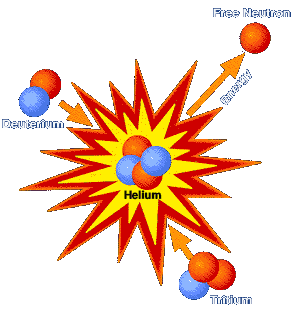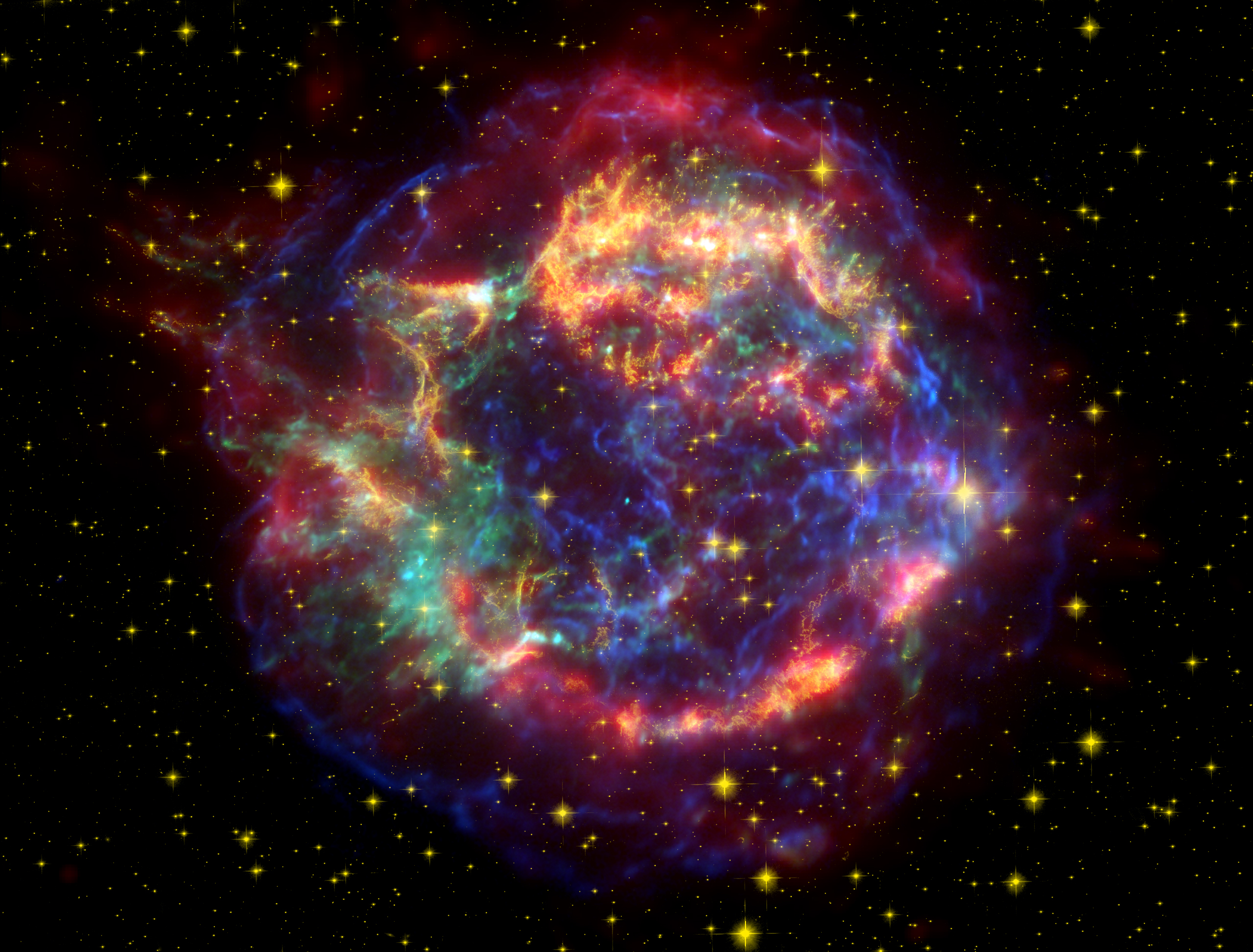SOLAR SUPERNOVA BACKGROUND
The essay below, "Why Stars Explode", will give you background information on, well, why stars explode. It was originally part of the Supernova Educators Guide, a series of activities about supernovae created as part of the XMM-Newton and Fermi education and public outreach programs. The Solar Supernova references page may be of help as well. Solutions to the wrap-up Mad-Libs activity can be found here.
Why Stars Explode
The stars in the sky seem eternal and unchanging.
But that's an illusion. Like all things, stars are born, live out their lives, and eventually die, doomed to fade away. Stars like the Sun, which have a relatively low mass, age gracefully and die quietly after billions of years. But massive stars, with more than ten or so times the mass of the Sun, "do not go gently into that good night, but instead rage, rage against the dying of the light." They explode in a catastrophic detonation, sending their outer layers screaming outwards at a few percent of the speed of light: what astronomers call a supernova.
 The seeds of a star's ultimate destruction are planted deep
in its core, where its energy is generated. Stars are giant
balls of gas, and when a gas is compressed it heats up. Because
stars are so big they have a lot of gravity, so at the core of a
star the pressure is intense. This means they get very hot, hot enough to
smash together atomic nuclei. And when nuclei collide, they
can stick together in a process called fusion. This process
releases a lot of energy (in fact, it's what makes hydrogen bombs
explode), which heats up the core. In a stable star like the Sun,
the inward crush of gravity is balanced by outward pressure caused by
the heat.
The seeds of a star's ultimate destruction are planted deep
in its core, where its energy is generated. Stars are giant
balls of gas, and when a gas is compressed it heats up. Because
stars are so big they have a lot of gravity, so at the core of a
star the pressure is intense. This means they get very hot, hot enough to
smash together atomic nuclei. And when nuclei collide, they
can stick together in a process called fusion. This process
releases a lot of energy (in fact, it's what makes hydrogen bombs
explode), which heats up the core. In a stable star like the Sun,
the inward crush of gravity is balanced by outward pressure caused by
the heat.
Already we see that the mass of the star is important: it provides the gravity needed to compress the core. The higher the mass of the star, the more the core is compressed, and the hotter it can get. Fusion reactions depend strongly on temperature; the higher the temperature, the faster the reaction proceeds. As we'll see, this is critical later in the star's life.
 Initially, the star fuses hydrogen into helium. Like ash in
a fire, the helium builds up in the core, but it does not
fuse because helium takes a lot more pressure and heat than hydrogen does
to fuse. If the star is massive enough, though, it can ignite
helium fusion in its core. The helium fuses into carbon, which
then starts to pile up in the core. In very massive stars this
process repeats again and again, fusing lighter elements into
heavier ones: hydrogen to helium, helium to carbon, carbon to neon,
neon to oxygen, oxygen to silicon, silicon to iron.
The star's core starts to look like an onion, with layers
nested inside one another.
Initially, the star fuses hydrogen into helium. Like ash in
a fire, the helium builds up in the core, but it does not
fuse because helium takes a lot more pressure and heat than hydrogen does
to fuse. If the star is massive enough, though, it can ignite
helium fusion in its core. The helium fuses into carbon, which
then starts to pile up in the core. In very massive stars this
process repeats again and again, fusing lighter elements into
heavier ones: hydrogen to helium, helium to carbon, carbon to neon,
neon to oxygen, oxygen to silicon, silicon to iron.
The star's core starts to look like an onion, with layers
nested inside one another.
At every step, the process generates more heat, and the fusion goes ever faster. A star may fuse hydrogen into helium for millions or billions of years, but by the time it starts to fuse silicon into iron, it may take mere days. As iron piles up in the core, the star is headed for disaster.
 Why? Because up until iron, all the fusion reactions have produced
energy in the form of heat. However, there is not enough heat and pressure to fuse
the iron nuclei, so once iron builds up in teh core, the star's source
of energy shuts off. Worse, the electrons in the core combine with the
protons in the iron nuclei to form neutrons - and the electrons
were crucial to give the star support as well. When they are removed from the star's core,
things quickly go bad.
Why? Because up until iron, all the fusion reactions have produced
energy in the form of heat. However, there is not enough heat and pressure to fuse
the iron nuclei, so once iron builds up in teh core, the star's source
of energy shuts off. Worse, the electrons in the core combine with the
protons in the iron nuclei to form neutrons - and the electrons
were crucial to give the star support as well. When they are removed from the star's core,
things quickly go bad.
The iron core collapses, since the heat and electrons holding it up get used to fuse the iron. The tremendous gravity of the core collapses it down from thousands of kilometers across to a ball of compressed matter just a few kilometers in diameter in a thousandth of a second. This is a bit like kicking the legs out from under a table. Just like when Wile E. Coyote suddenly realizes he is no longer over solid ground and starts to fall, the outer layers of the star come rushing down. They slam into the compressed core at a significant fraction of the speed of light.
This does two things: it sets up a huge rebound, sending the outer layers of the star back out, and also releases a vast number of neutrinos, subatomic particles that carry away most of the energy of the collapse. The gas from the outer layers absorbs only a small fraction of these neutrinos, but that's still a lot of energy: it's like lighting a match in a fireworks factory. The outer layers of the star explode upwards, and several solar masses of doomed star (containing the elements that were produced before the explosion) tear outwards at speeds of many thousands of kilometers per second.
As the star explodes, the expanding gas is so hot that it can undergo temporary fusion, creating elements as heavy as uranium. This, plus other radioactive elements created in the explosion, dumps even more energy into the gas, causing it to glow. The expanding gas is called a supernova remnant; it will expand for hundreds of thousands of years, eventually cooling and becoming so thin it merges with the tenuous gas between the stars. Sometimes the gas from the remnant will hit and mix with gas that is forming new stars, seeding it with the heavy elements formed in the explosion. The iron in your blood and the calcium in your bones were formed in the supernova explosion of a massive star millions of years before the formation of the Earth itself.

Credit: NASA/JPL-Caltech/STScI/CXC/SAO
And what of the core? Like the life of the star itself, the fate of the core depends on its mass. In relatively low-mass stars like the Sun, the star never explodes at all. The core is not massive enough to fuse helium, so helium simply builds up. Or perhaps helium does fuse, but then the star is not massive enough to fuse the resulting carbon. In any event, the outer layers of the star are blown off by a solar wind over millions of years, and the naked core, unable to generate its own heat, simply cools and fades away. A star that consists of this revealed core is called a white dwarf.
If the core is more massive, between 1 and 3 times the Sun's mass the things are different. The pressure from the collapse slams electrons into protons, creating neutrons. The core shrinks to a size of a few kilometers across, and is comprised almost totally of these neutrons. The collapse is halted by the neutrons themselves, which resist the pressure. Not surprisingly, this object is called a neutron star.
And for more massive cores? Even the neutrons cannot resist the pressure created by more than about 3 times the Sun's mass when it collapses. The core implodes, and nothing can stop it. Its gravity increases hugely, and anything that gets too close will be drawn in, even light. It has become a black hole.
This is more than just a guess. By studying supernovae, supernova remnants, and other exotic objects, astronomers have discovered all this and much more.